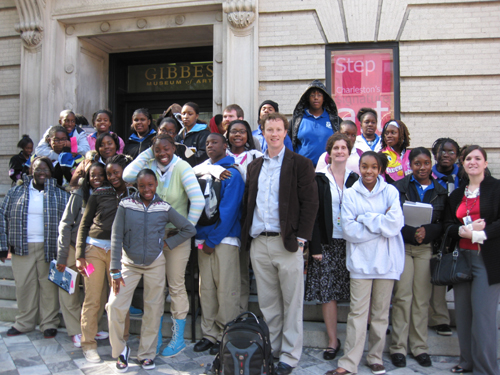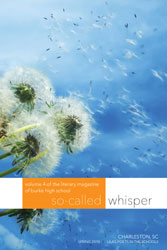
Last year, 50 students from Burke High School, many of whom had never been to the Gibbes or any other art museum, spilled out of a bus on a December morning, toting legal pads and pencils. Two hours later they left with a thick stack of stories and poems inspired by paintings and sculptures. Some wrote as much as five pages.
Getting students to write poetry about art (the term is ekphrastic poetry, but you have to find a pretty big dictionary to find it), involves more than just letting them loose in the museum and telling them to “use their imaginations.”
The first thing I tell kids is I don’t want them to try and come up with right answers. Don’t try and guess what the painting is about or what the artist thought. I want you to write something only you can write.
I usually like to start at a portrait. I ask a series of leading questions. What’s this girl’s name? Where does she live? What sort of smells are in the air? What’s she holding behind her back? What sounds? And name names: don’t just say she hears music, name a song. Of all the exercises I do, these kinds of stories are often some of the longest. It’s fine if kids get carried away and stop listening to my questions, that’s the point.
With a painting like The Green Fan by Robert Henri, the last thing I hope to see are stories about a fourteen-year-old who lives in Toledo, Spain. So much better to read Ariona Moten’s story about Benita from Argentina, on the run from police:
“In her left hand, she holds small scissors to cut her hair so she can disguise herself.”
I like to do Color Poems next, which are trickier. Sit most people in front of an abstract painting and ask them what the colors mean to them, you get a lot of stock answers—green grass and angry reds—even from children, who can be great, uninhibited poets. But if you can get them in the right mindset, maybe ask them to really stare at the painting till they see something they hadn’t seen before, then till they see something that’s not even there, you get lines like Jessika Washington’s:
“Orange can be tricky like the seeds in a watermelon.”
I’ve written with thousands of kids, and I have a lot of prompts ranging from bananas to Beethoven. But I got my start in writing workshops at the Gibbes, as a poet-in-residence in the Poets and Painters program. I’ve always loved the way the art and the architecture of the museum can instantly change a kid’s attitude towards his own work. Besides last year’s annual trip by Burke, which was led by poets Richard Garcia, Marjory Wentworth and myself, I bring five sessions of my summer writing camp to the museum. Sessions are a week long, and the Gibbes trip on Wednesdays are often the days heretofore reticent writers break out of their shells, or strong writers explode with creativity.
I believe in high expectations, and coming here with kids, it’s as though the collection is pushing the young talents to dig a little deeper. There’s a Picasso or Jasper Johns on the wall, but you’re here now, with your pencil, so what would you like to create? What’s something that only you can write?
—Jonathan Sanchez, guest blogger
 Jonathan Sanchez is the director of the Poets in Schools at Burke High School, a program of the Lowcountry Initiative for the Literary Arts (LILA), which is under the auspices of the College of Charleston. Each year, Jonathan and fellow writers lead workshops in the fall and compile a book of poems and stores. Volume four, So-Called Whisper, was just released and features eight paintings from the Gibbes which were on display last fall when the Burke students visited. Visit Blue Bicycle Books to learn more.
Jonathan Sanchez is the director of the Poets in Schools at Burke High School, a program of the Lowcountry Initiative for the Literary Arts (LILA), which is under the auspices of the College of Charleston. Each year, Jonathan and fellow writers lead workshops in the fall and compile a book of poems and stores. Volume four, So-Called Whisper, was just released and features eight paintings from the Gibbes which were on display last fall when the Burke students visited. Visit Blue Bicycle Books to learn more.
Published October 26, 2010

